Business View Magazine interviews Clyde Goldbach, Executive VP of Solutions By Design II, as part of our focus on the Information Technology sector.
“It’s not an easy business – federal contracting. It’s very different than commercial work.” So says Clyde Goldbach, Executive Vice President of Solutions By Design II (SBD2), an Information Technology (IT) and consulting services company that has been providing services, products, and solutions for departments and agencies of the United States Government since 2001.
“The key in the federal market is you have to develop the right relationships (with both government and industry partners), deliver quality results to your customers, attract and retain the right people, and have the right contract vehicles in place so agencies can get to you,” Goldbach explains. “We were pretty fortunate. We’ve got quite a large group of loyal and satisfied federal customers and a number of really good partners that have been key to our success in winning federal work.”
The “vehicles” to which Goldbach refers are the various government-wide and agency-specific purchasing mechanisms and socio-economic programs within the Small Business Administration (SBA) that outline how contracts can be competed for and awarded in the federal system. “My wife was able to qualify for the SBA’s 8(a) program” says Goldbach about his spouse and partner, Ms. Maria A.S. (Cida) Goldbach, SBD2’s President and CEO, to whom he has been married to for 28 years and worked side-by-side for nearly 25 years. The 8(a) Business Development Program is a business assistance program for small, disadvantaged businesses that are owned and controlled by at least 51 percent by “socially and economically disadvantaged” individuals. SBD2 graduated from that program a little over 3 years ago.
One important early contract for SBD2 was the GSA (General Services Administration) 8(a) STARS II Vehicle, a small business, set-aside GWAC (Government-wide Acquisition Contract) for 8(a) industry partners who provide customized IT solutions. “A lot of clients’ and partners recognized the value we could provide and looked for opportunities to team with us, and that worked out quite well,” Goldbach recounts. “There are quite a few different agencies that we work with and have contracts within, even after 16 years. Our forté is software engineering and cyber security but we also have video teleconferencing and some cabling work. We have had a broad range of offerings over the years.”
Today, the Vienna Virginia-based company has approximately 200 employees, and, last year, it was ranked #1061 in the 2016 Inc. 5000 Fastest Growing Companies category and #36 on the 2017 Washington Fast 50. Its portfolio of contracts covers a wide range of U.S. government departments and agencies. For example, for the Department of Homeland Security’s (DHS) United States Citizenship and Immigration Services (USCIS), SBD2 provides cybersecurity support and operates a 24x7x365 security operations center. The company provides Instructional Design and Development to help Air Traffic Controllers with Pre-Departure Clearance regulations, i.e. training and implementation of software to enable training for the Federal Aviation Administration (FAA). For the Environmental Protection Agency (EPA), SBD2 designed and implemented a progressive User Experience Campaign, integrating marketing and outreach activities, enhancing content, and leveraging e-learning technology. For the Department of Housing and Urban Development (HUD), SBD2 provides a full lifecycle of Application Development and Maintenance support. For the Small Business Administration (SBA), SBD2 conducted cost-benefit analysis of multiple software engineering alternatives for facilitating their modernization efforts. For the Department of Interior (DOI), SBD2 provided Portal and Web Development. For the Social Security Administration (SSA), SBD2 provides Data Exchange and Warehouse Repository for more than 3 Terabytes of data. For the Centers for Medicare and Medicaid Services (CMS), SBD2 is responsible for ingesting, normalizing, and disseminating “big data,” including all insurance plans for Healthcare.gov. Most recently CMS awarded SBD2 the contract to replace the Provider Enrollment, Chain, and Ownership System (PECOS), an electronic Medicare enrollment system that will be built on a modern technology stack in a cloud environment to be flexible, scalable, and easy to use.
“That’s been the path we’ve taken,” Goldbach says. “And we’ve experienced pretty high compounded growth over the last few years.” He admits, however, that there are some challenges in the federal contracting system: “This past year, some awards have been protested. Somebody that loses challenges the decision, and we’re kind of suffering a bit because there are a couple of protests that are delaying a couple of awards that we recently received. The protests typically revolve around the government’s evaluation of the proposals – whether the pricing was fair, or whether their proposal was given adequate evaluation. That’s one challenging part with federal contracting – sometimes you don’t know what ultimately will happen and sometimes it takes years to get an award. However, we were recently notified that a protest over SBD2’s largest contract award to date was denied. Now it’s time to get to work!”
Another challenge for companies such as SBD2 is the constant changes in federal programs and legislation that directly affect department budgets and thus the availability of contracts. “We support the Affordable Care Act on the insurance carrier side,” Goldbach says. “So, legislation and change around that could potentially have an impact on us – it might be positive, it might not; we don’t know for sure. That’s an area we’re tracking. And there’s a lot of concern about the EPA – they’re trying to reduce a lot of the EPA budget. We recently had a contract at EPA terminated due to budget reductions and insourced for agency staff to perform. All part of being a federal contractor.”
“The government has relatively, well-defined criteria against which to evaluate proposals,” Goldbach continues. “What they’re looking for is a company that can demonstrate that they’ve done it before: ‘Can you cite other contracts similar in size, scope and complexity? How well did you perform on those?’ The government also has an appraisal system that tracks every time we do a contract. The agency evaluates us and gives us a grade of how well we’ve done. So part of it is prior work. And then in the new proposal solicitation they’ll ask you to describe your approach for management: ‘How will you solve this problem? What is your procedures? How would you staff it? Who are the key personnel to perform the services on the project? What are their credentials?’ So, you have to differentiate yourself in how you would do the work, how you would solve their problem, meet their needs. You have to demonstrate, through this narrative content that you provide as part of your response, that you’re better than anybody else. And then pricing is obviously a big factor – it may not be the only factor, but it’s always important – the government is always trying to get the best value for its investment, and it’s trying to weed out the inferior vendors that don’t perform, that don’t deliver, that don’t produce the quality solutions, and don’t stand behind their work.”
SBD2 stays in the game by adapting to change while still maintaining its high level of customer service. “We have to be fairly nimble,” Goldbach states. “We have to be agile in a lot of ways to adapt to the changing landscape. When the DOD (Department of Defense) was cutting its budget, they would come back to us and ask us to sharpen our pencil for a way we could reduce costs while continuing to support their mission. It’s our job to make sure we can provide high quality value to the government at a fair price. One of our mantras is: ‘Performance over Price.’ It’s more important to perform than to drive profit, per se, because performance leads to future opportunity. Make the customer happy and they’ll come back to you. We don’t necessarily look for savings, directly, but we do look for ways to help the government be more efficient and more effective, building systems and processes that help them do the job better. And I think we’ve been rewarded, because we’ve always approached it from that perspective.”
Goldbach continues, “In addition, we have had to look at where we want to be in the next two to three years and plan accordingly. I think what a lot of small businesses forget to do is look past today and where they want to be in the future. It is easy to get caught up in the success of winning contracts, but it is those companies that focus on where they want to be in the future that are able to successfully transition from small to mid to large businesses and we want to be one of those companies. When one is small, any work is great work, but as you become large, that model won’t work all that well. You have to be focused. Competition becomes more intense. The earlier a small business starts that process, the better off they will be all around in the long run. Consequently, we have spent a lot of time over the past two years developing our vision to 2020, and I would like to say that we are executing against it pretty effectively. The biggest key to how we will get there is focus, as I mentioned, and not being distracted by things (which is sometimes hard to do), but executing against our plan and spending the time, money, and resources on the things that matter, and the things that will get us to where we want to be.”
In addition to SBD2’s operating ethos, Goldbach reiterates the three main things that have combined to foster the company’s success in the federal space: contract vehicles, key partners and relationships, and most of all, its own employees. “We recognize how important our people are,” he declares. “They’re the touch point for our customers. We have an outstanding management staff and our vision is wrapped around our people delivering high-quality services. All those things came together for us in a positive way and that has allowed us to succeed.”
AT A GLANCE
WHO: Solutions by Design II LLC
WHAT: An information technology and consulting services company
WHERE: Vienna, Virginia
WEBSITE: www.sbd.com



